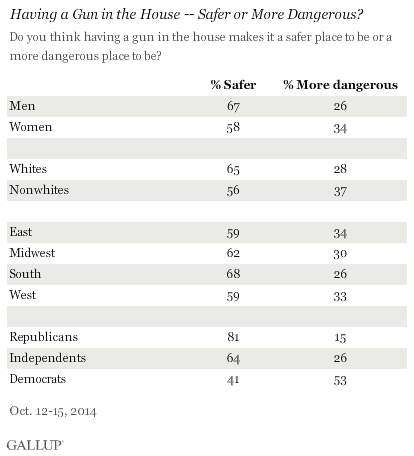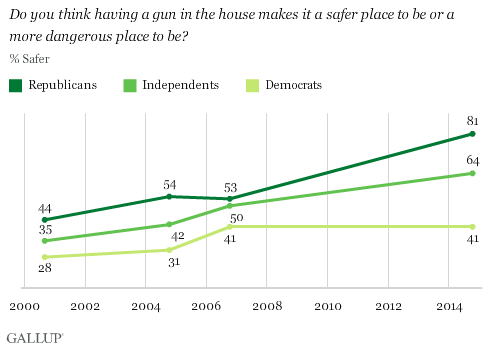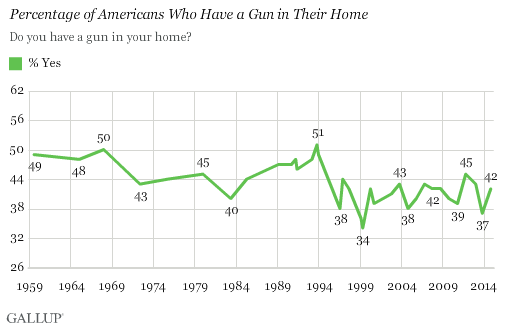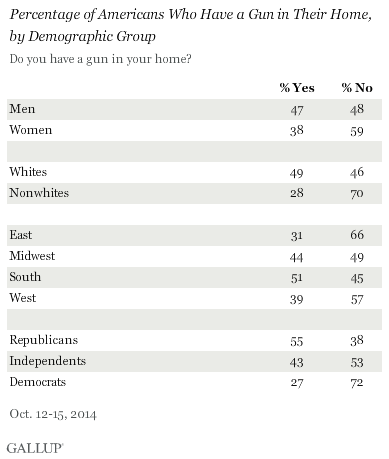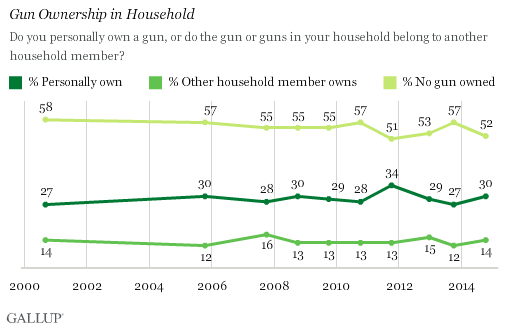(Originally posted by Gallup)
The percentage of Americans who believe having a
gun in the house makes it a safer place to be (63%) has nearly doubled
since 2000, when about one in three agreed with this. Three in 10
Americans say having a gun in the house makes it a more dangerous place.
Gallup originally asked Americans about their views on the
implications of having a gun in the home in 1993, and then updated the
measure in 2000. Between 2000 and 2006, less than half of Americans
believed having a gun at home makes it safer -- but since then, this
percentage has significantly increased to a majority.
Republicans (81%) are about twice as likely as Democrats (41%) to
believe having a gun improves home safety. About half of Democrats say
having a gun makes a home a more dangerous place to be.
Although there is a gender gap in the results for this question,
majorities of both men (67%) and women (58%) believe having a gun
improves home safety. While one in three women say it makes for a more
dangerous place to be, only one in four men say the same about guns in
the home.
About two-thirds of whites and Southerners endorse having a gun to
improve home safety, as do majorities of nonwhites (56%) and residents
of the other three regions.
Since 2000, Americans of all political stripes have become more
inclined to believe a gun makes a home more secure. But the rate of
increase has been greatest among Republicans, with 81% now holding this
position, up from 44% in 2000.
While those who identify with the GOP have seen a 37-percentage-point
growth in this sense of safety, independents show a 29-point climb and
Democrats show a 13-point increase.
More Than Four in 10 Americans Keep a Gun in Their Home
Forty-two percent of Americans report having a gun in their home,
similar to the average reported to Gallup over the past decade. This
self-reported measure has fluctuated from survey to survey, but is
consistent with trends since 2004. Longer term, Gallup has found that
household gun ownership has ranged from a low of 34% in 1999 to a high
of 51% in 1993.
Republicans are twice as likely as Democrats to have a gun in their
house. A majority of Southerners say there is a gun in their home, much
higher than the rate among those in the West and East.
Men are about equally as likely to have or not have a gun at home. About six in 10 women say they do not have a gun in the home.
Most survey respondents report that the gun in their household
belongs to them personally (30%), as opposed to another household member
(14%). This means that about one in three people who have a gun in
their home are not personally owners, but are aware the gun is there.
The personal ownership trend has been generally stable over the past 13
years.
Americans who have a gun in their household are significantly more
likely than others to say that having a gun makes a home safer (86%),
though one in 10 believe it makes a household more dangerous.
Bottom Line
While Gallup figures on U.S. gun ownership have not shifted much
since 2006, the percentage of Americans who say that having a gun in the
home makes that household safer has drastically climbed over the past
eight years.
Americans own guns for a wide array of reasons, but the increase in
the perceived safety value of owning them suggests that guns are taking
on more of a protective role than they have in the past. Florida passed
the nation's first "Stand Your Ground" law in 2005, followed by dozens
of states that passed different versions of the law. In the decade
since, Americans have become more likely to view guns as a means of
self-protection.
Regardless of Americans' perceptions of crime and their need to
protect themselves, violent crime rates fell significantly from 1993 to
2012. While it may be a contentious assertion, some attribute falling
crime rates to increased gun sales.
What do you think? Are homes safer with firearm protection? Would you feel less secure if you did not have firearms in your possession?



